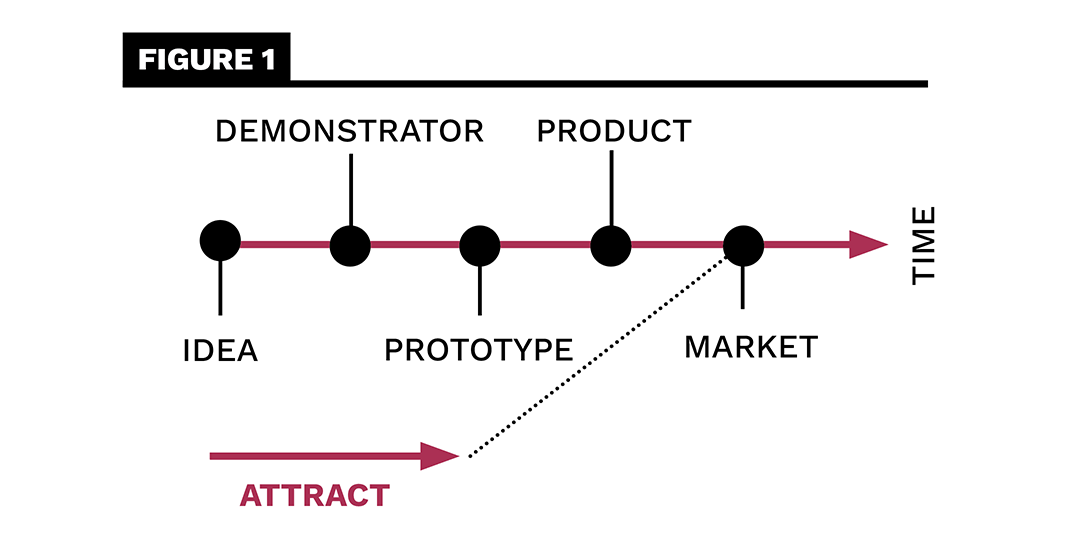By Hervé Legenvre
DeepTech technologies have significant effects on the economy and are an avenue to solve many problems humanity faces. However, the vitality of DeepTech projects is linked to the innovation ecosystems in which they are embedded. In this article, Hervé Legenvre explores the role of innovation in DeepTech success using the ATTRACT programme.
Innovation is the art of abolishing distances. Innovation thrives by combining distinct, diverse, and previously unconnected capabilities and resources to solve problems. This is particularly true for DeepTech Innovation. ATTRACT is an initiative that created a Pan-European DeepTech ecosystem that spans detection, imaging, and computing technologies. It assembled around 170 DeepTech projects in an ecosystem comprising scientific research institutions, universities, business networks and hundreds of students from across Europe. ATTRACT takes the art of innovation to its next level by steering open and interdisciplinary cooperation across a diverse network of stakeholders.
Innovation as the art of combining the power of distant objects
Adam Smith’s book, The Wealth of Nations is renowned for the description of the division of labour, where the production process is segmented into a series of small, specialised tasks, each carried out by a distinct worker, enhancing overall efficiency. Smith’s illustration of this through a pin factory is well-known. Yet, the subsequent passages in this book that portray innovation as the art of linking disparate resources and expertise are less cited. He noted.
“Many improvements have been made by […] philosophers or men of speculation, whose trade it is not to do anything, but to observe everything; and who, upon that account, are often capable of combining together the powers of the most distant and dissimilar objects.”
In today’s era of high specialisation and continuing knowledge expansion, philosophers are scientists, and men of speculation are entrepreneurs, but innovation remains the art of combining disparate capabilities, resources, and expertise to solve problems. This art is essential to convert scientific discoveries into economic and social benefits. Bringing DeepTech projects to market requires uniting many elements that are diverse and distinct and initially disconnected.
What are DeepTech technologies?
DeepTech solutions require long and uncertain development cycles, significant capital investment, and a deep understanding of the underlying scientific principles.
In the rapidly evolving world of technology, the term “DeepTech” describes technologies that are rooted in groundbreaking scientific discoveries and high-tech innovations. These are not the apps or software we use every day at work or in our lives; they are technologies born out of significant scientific advancements and discoveries. DeepTech projects can sometimes be taken to market by new ventures but also by collaborative projects where large companies and scientists work together. The applications of DeepTech innovations are often not confined to a single industry. They are often pervasive and impact a wide array of sectors. They have broad-ranging effects on the economy, improving efficiency and productivity across many different industries. They are also regarded as an avenue to solve some of the most pressing problems humanity faces. Unlike consumer-focused apps or software, DeepTech solutions require long and uncertain development cycles, significant capital investment, and a deep understanding of the underlying scientific principles. DeepTech ventures often struggle with raising money due to their longer gestation periods and higher research and development (R&D) investments. Entering different markets is a major hurdle for DeepTech projects. Different countries and sectors have their own unique culture, language, and business practices.
The role of innovation ecosystems and public policies in DeepTech success
With such challenges, DeepTech projects need support from powerful innovation ecosystems and public policies. DeepTech projects can gain considerably from supportive public policies. Governments can allocate funds for DeepTech R&D. This can take the form of grants, tax incentives, or direct investment in research initiatives. Such funding helps DeepTech projects overcome the initial capital-intensive phase of development where private investment might be risk-averse due to the long-time horizons and uncertain outcomes associated with these projects. Public policies also support education and training at the intersection of technology and the economy to enlarge the talent pool available to DeepTech companies. DeepTech challenges and opportunities transcend national borders; it is therefore key to have public policies that promote international collaboration so DeepTech projects can connect a more global innovation network. In a nutshell, governments play a crucial role in shaping the ecosystem within which DeepTech projects operate.
The vitality of DeepTech projects is linked to the innovation ecosystems in which they are embedded. These ecosystems bring together complementary resources and expertise to nurture these projects. Research Institutions and universities are the seedbeds of science and DeepTech innovation. They are also the training grounds for the next generation of scientists, engineers, and entrepreneurs. Large companies act as partners for DeepTech projects, providing the scale, resources, and industry expertise necessary to bring DeepTech innovations forward. Startups can also emerge out of DeepTech projects, they are often the vehicles that take nascent technologies out of the lab into the market. Venture capital firms, angel investors, and other financing entities can also play a role when the time is right. These investors also bring their business acumen, mentorship, and networks that can help DeepTech entrepreneurs.
The origin of ATTRACT
ATTRACT is a pioneering initiative bringing together Europe’s fundamental research and industrial communities to lead the next generation of detection and imaging technologies. Funded by the European Union’s Horizon 2020 programme, it aims to help revamp Europe’s economy and improve people’s lives by creating products, services, companies, and jobs. By funding this project, the European Union aims to foster innovation from the earliest stages of technological development to market entry and beyond and to create positive societal impacts.
The ATTRACT initiative represents a strategic and collaborative effort to harness the innovative potential of pan-European research infrastructures and their associated communities. The consortium that orchestrates ATTRACT activities includes Aalto University, the European Organization for Nuclear Research (CERN), the European Industrial Research Management Association (EIRMA), the European Molecular Biology Laboratory (EMBL), ESADE Business School, the European Southern Observatory (ESO), the European Synchrotron Radiation Facility (ESRF), the European X-Ray Free Electron Laser Facility (European XFEL), and the Institut Laue-Langevin (ILL).
The core objective of ATTRACT is to bridge the gap between fundamental research and marketable solutions by engaging entities capable of translating high-level research into societal and commercial gains. ATTRACT has created a rich ecosystem that meshes Pan-European research infrastructure, universities and industry representatives. Research infrastructure initiatives and universities are hotbeds for advanced scientific inquiry and technological development. They are equipped with state-of-the-art facilities and are staffed by researchers working at the frontiers of knowledge across various disciplines. Industry players bring a commercial perspective to the table. They can help create connections between the generation of knowledge and its practical application.
A structured innovation process for DeepTech projects
ATTRACT offers a structured process to identify and develop breakthrough technologies in the field of detection and imaging. By selecting 170 potential projects, ATTRACT focusses resources on the most promising ideas that have the potential to address societal challenges and fill gaps in the market. In its first phase, ATTRACT helped validate and test these concepts through a gradual and phased approach as illustrated in Figure 1.
In the context of ATTRACT, a demonstrator is an early version of the technology that is used to demonstrate its potential, performance and viability to stakeholders including early investors or partners. A prototype is a more advanced application of the technology, dedicated to a specific market. Prototypes help test and refine the functionality of a product, identify issues, and present the concept to stakeholders including potential users.
The first phase of the ATTRACT Project also serves as an initial financier backed by the European Union Horizon 2020 programme. A €20 million funding from Horizon 2020 supports the selection of 170 technology concepts via an Open Call to consortia comprising Research Infrastructures (RIs), academic institutions, Research and Technology Organisations (RTOs), and industry partners. Each successful proposal received a one-time payment of €100,000 to initiate the first steps of the project.
The second phase of ATTRACT helps bring XX project closer to a market-ready stage. Here, there is a focus on the proven and most promising breakthrough technology concepts from the previous phase showing strong potential for scientific, industrial and societal applications.
A springboard for interdisciplinary education
ATTRACT focusses resources on the most promising ideas that have the potential to address societal challenges and fill gaps in the market.
The ATTRACT Programme also adopted an “Open Science to Open Innovation” approach by training students in an interdisciplinary manner. This closes a gap in the current education landscape which often limits students to specialised activities without interdisciplinary interaction or entrepreneurial training. The goal is to move beyond the traditional, siloed approach to research and instead imbue students with Design Thinking and similar methodologies. Using these methodologies, groups of students coming from different horizons envision how the DeepTech projects of ATTRACT can be used to solve real-world problems. This fosters an entrepreneurial and co-creation mindset among students, demonstrating how these approaches can mesh scientific research and social innovation. The initiative is designed not only to enrich the educational experience of students but also to contribute to a more innovative and evenly distributed logic of innovation.
What is ATTRACT’s secret recipe?
Innovation is the art of abolishing boundaries and distances. Innovation often emerges from the combination of different and previously unrelated elements such as specialised knowledge, practical skills, advanced equipment, financial backing, and real-world challenges across various industries.
The ATTRACT initiative is about fostering a community as much as it is about advancing technology. It’s not merely a source of funding; it’s a networked environment where sharing ideas and support is standard practice. Central to ATTRACT is the idea that a diverse range of contributors can enable the development of DeepTech innovation. This community includes research institutions and universities that lay the groundwork for new ideas through fundamental research and provide the intellectual and physical resources to develop these ideas further. Students and business networks contribute new perspectives and energy, while public funding, companies and venture capitalists bring the necessary investment and business expertise to help turn promising ideas into market-ready products.
This collaborative approach within ATTRACT is designed to encourage openness and interdisciplinary cooperation, making it easier for people to learn from one another and work together effectively. By facilitating connections among these varied elements, ATTRACT helps to develop nascent ideas into mature projects. ATTRACT speeds up the development and application of new technologies, broadening their potential impact. This approach showcases the value of enabling collaboration across different disciplines and sectors to drive innovation forward.
Example of projects supported by ATTRACT
ULTRARAM
ULTRARAM is a new type of computer memory that uses very little energy with the speed of DRAM and the non-volatility of flash memory. It’s designed to save a lot of power in places like data centres and satellites in space. The next step for the project is to test ULTRARAM’s ability to hold data for a long storage time and its endurance level. This could change how all kinds of devices, from tiny sensors to big data centres, store and use data. The ULTRARAM team is led by Manus Hayne from Lancaster University, it is now supported by the award-winning startup Quinas Technology as it won the title of “Most Innovative Flash Memory Startup” in Silicon Valley.
RANDOM POWER
The Random Power taps into the quantum characteristics of semiconductors to create a secure and continuous supply of random data bits, crucial for encryption. In its first phase, the project team which included research institutions and companies, successfully engineered a compact, credit card-sized device that generates these random bits and passed US National Institute of Standards and Technology tests, confirming its practicality for real-world use. The project led by Massimo Caccia from the Università dell’Insubria has since grown to include a new company formed from the original team and has broadened its expertise by collaborating with other projects. The goal now is to develop a range of True Random Bit Generators that can be used across various industries, from large-scale infrastructure to the IoT and automotive sectors, enhancing security with quantum-level unpredictability.
The author would like to thank the ATTRACT team for their support and for making this article possible. This includes Pablo Garcia Tello, Markus Nordberg and John Wood.









































